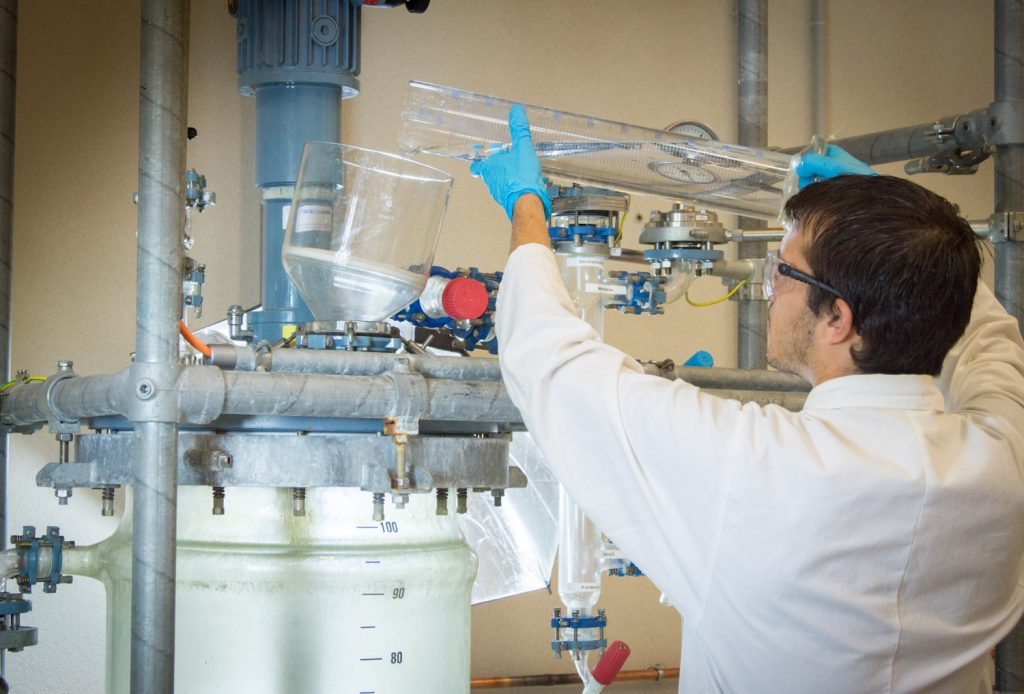Expert in sol-gel technology and application, while keeping the performance/cost ratio, POLYRISE offers innovative and unique solutions for mass markets. What about this technology? What advantages does POLYRISE bring to the surface treatment industry? Focus on this sol-gel process made in POLYRISE.
FROM SOLUTION TO GELIFICATION
The sol-gel technology is a process used for the manufacture of vitreous materials, ceramics and organo-mineral hybrid materials.
The principle of the sol-gel process is similar to the synthesis of polymers. This consists in forming a network of metal oxides by polymerization of inorganic or organo-metallic precursors in a solvent (alcohol and/or water).
There are generally two ways of sol-gel synthesis :
- Synthesis in basic conditions of inorganic precursors then formation of dense 3D networks or colloidal suspensions of oxides or ceramics. With a control of the conditions of synthesis then of formulation, it allows the synthesis of porous films with properties of low optical indices for example.
- Synthesis by polymerization of organo-metallic precursors in acidic conditions. This is the most used method to have greater modularity with respect to the final properties envisaged for the material. The precursors used are metal alkoxides, Me(OR)n, where R is an organic group, and Me often silicon, but this can be replaced by zirconium but also titanium, aluminum, vanadium. .. It is also possible to obtain a coating based on a combination of several precursors, a zirconium alkoxide and a silicon alkoxide for example.
All of these reactions take place at low temperature and can be combined to produce structures of complex materials such as nanocomposites. This allows, among many other examples, the molecular assembly of hybrid organic and mineral objects, or even to coat supports with low thermal resistance.
The applications of these materials are various : colored glasses (solid dye lasers), functional coatings on hydrophobic panes created by biomimicry and for micro-optics and micro-electronics, sensors and bio-sensors , etc.
SOL-GEL TECHNOLOGY MADE IN POLYRISE
POLYRISE, expert for more than 15 years in the research and development of thin film materials in the field of optics, naturally turned to this sol-gel technology because of this soft and versatile chemistry allowing access to a wide range of materials and offering numerous application possibilities.
The sol-gel process developed by POLYRISE is based on the synthesis of hybrid materials by the precursors of glasses in hydro-alcoholic phase. It involves a diversity of materials by mixing in an innovative and original way the technological bricks created by Polyrise (colloids, networks dense polymeric oxides, nanocomposites, etc.). Materials adapted to different uses and contexts of use are thus accessible: optical sofas, protective layers, barrier sofas, etc.
This solution of precursors will thus be deposited on the parts to be treated, by dip-coating or processes allowing localized applications such as spraying for example. It is at this stage that the low temperature sol-gel transition occurs. This particular condition specific to the sol-gel process makes it possible to coat and functionalize fragile substrates such as polymer parts and films by obtaining a layer of hybrid glass on the surface. It is then necessary to provide this layer, to harden it, to densify it so that it has optimal properties with respect to the final application. In certain processes, this gelling must take place at high temperature, in the case of glass or sapphire substrates for example. However, not all substrates support it, but the versatility of POLYRISE’s sol-gel processes also makes it possible to consider densification under UV radiation. Low-temperature or UV densification processes make it possible to create interpenetrating networks between the organic and the inorganic.
In terms of properties, this diversity of precursors, capable of reacting just as well with an inorganic network of oxides as with an organic network, makes it possible to play on the mechanical resistance of the coating, the adhesion on PMMAs for example, the capacity to withstand thermal variations. It is also associated with the implementation of different optical properties, particularly in terms of refractive index. Thanks to its know-how, POLYRISE offers the possibility of a range of materials ranging from 1.3 to 2.9 in optical index by playing on the nature of the precursor (titanium oxide, zirconias, aluminas but also silica type , magnesium fluoride). This additional aspect of structuring the material leads to a modulation of the optical properties to go, for example, to seek very low refractive indices, or to provide anti-reflection properties.
Through this sol-gel process, POLYRISE also offers a wide range of layer thicknesses, ranging from a few tens of nanometers to around ten microns while controlling their transparency.
POLYRISE EXPERTISE
POLYRISE is thus differentiated by the physico-chemical properties provided by the precursors of hybrid glasses, the diversity of the substrates on which this treatment can be used (nature of the substrate, simple and complex shapes), and the application processes. Its know-how is, among other things, the synthesis of stable products in solution, with property thresholds close to those obtained on the final layer without exceeding this gel threshold and then moving towards the final gelation phase. POLYRISE’s expertise is also based on its knowledge of the fields of optics, photonics, and the strict specifications of manufacturers for use of coatings in harsh environments. POLYRISE has extended its know-how to an industrial scale allowing mass production, while controlling the physico-chemical properties of the layers and the production costs.

